I Scream, You Scream, We All Scream
for Ice Cream
by Bob Brooke
QUESTION:
I remember when I was a kid and my
dad would take my sister and I to get ice cream at the local ice cream
parlor. My eyes didn’t know which flavor to choose, so I’d end up with
plain old vanilla. My dad and sister laughed at me. But what fascinated
me was how the
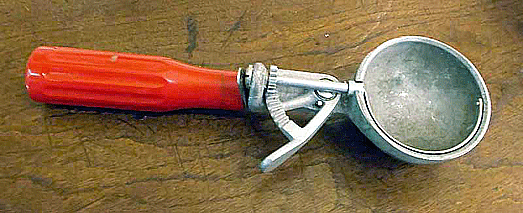
attendant would scoop out the ice
cream into perfectly round balls of goodness, then mount them on top of
a delicate sugar cone. So when I became an adult, I started collecting
ice cream scoops. And even though I have about 35 of them, I honestly
don’t know much about them. What can you tell me?
Thanks,
Harold
_________________________________________________________
ANSWER:
It seems everyone takes the ordinary ice cream scoop for
granted. Without it, ice cream cones would not be possible.
Godey's Lady's Book stated in 1850 that ice cream had become
one of the necessities of life. It said, "A party without
ice cream would be like a breakfast without bread or a
dinner without a roast."
 Ice
cream is the most popular dessert in the United States. It’s
a frozen food that not only tastes good but is good for you.
And while there are many collectibles associated with the
ice cream industry, one of the most popular is the ice cream
scoop. Ice
cream is the most popular dessert in the United States. It’s
a frozen food that not only tastes good but is good for you.
And while there are many collectibles associated with the
ice cream industry, one of the most popular is the ice cream
scoop.
But before answering your question about ice cream scoops,
let’s take a look back to where ice cream originated.
Historians believe ice cream originated in China about 2,000
BCE. It began as a mixture of ice, milk, and rice and soon
became a favorite dessert.
Marco Polo introduced ice cream to Italy. From there it
spread to the rest of Europe in the 17th century. About 1660
an Italian called Procopio opened the Cafe Procuge, where he
sold ices. Fifteen years later there were about 250 ice
cream dealers in Paris, France.
There are many legends about the origins of ice cream that
are very interesting. Ladies of Rome liked to chew ice. Nero
enjoyed snow flavored with honey. And Roman writings mention
a frozen cream called “melca.” In the 17th century Charles I
of England was having a state banquet. Although the menu
consisted of many delicacies, the hit was a new dish—a
dessert served cold that was sweet and creamy. It delighted
his family and friends, so Charles paid the cook that
created this new dinner dessert not to divulge the secret of
how he did so. Needless to say, the cook did not keep his
promise.
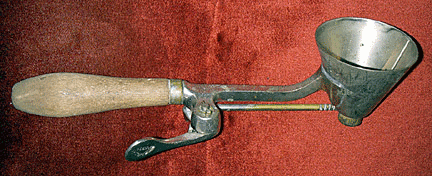
Though ice cream appeared in the American Colonies in the
1600s, the first recorded instance of its appearance in
America was in 1744. A gentleman, visiting the governor of
Maryland, said, "We had a dessert no less curious among the
rarities of which it was composed was some fine ice cream,
which with strawberries and milk was most delicious." Ice
cream became big business around the start of the 19th
century.
Ralph Waldo Emerson once said, "We dare not trust our wit
for making our house pleasant to our friends, so we buy ice
cream." Evidently, it put a smile on people’s faces.
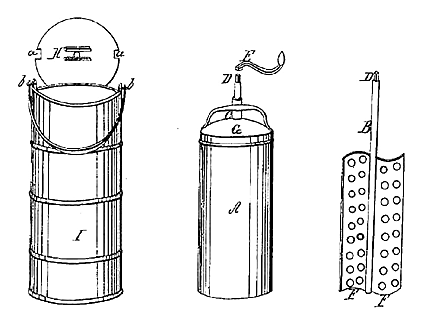 In
1846 Nancy Johnson invented an ice cream freezer for home
use. Present day ice cream freezers use the same principles.
These ice cream freezers enabled people to make and eat ice
cream in their own homes. In
1846 Nancy Johnson invented an ice cream freezer for home
use. Present day ice cream freezers use the same principles.
These ice cream freezers enabled people to make and eat ice
cream in their own homes.
In 1904 the ice cream cone was introduced at the St. Louis
World's Fair. By the 1920s, people realized the nutritional
value of ice cream, and the industry took off. Today
Americans eat far more ice cream than any other country.
Ice cream scoops
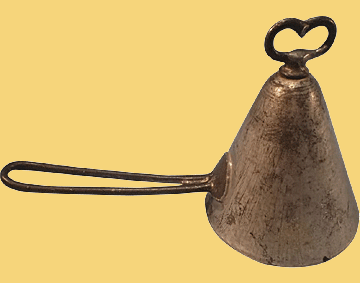 Originally,
ice cream scoops came in many different sizes and shapes,
such as cone, cylinder, round and square. Though people call
this device an ice cream scoop today, it had many other
names, including disher, dipper, spoon, ladle and dispenser. Originally,
ice cream scoops came in many different sizes and shapes,
such as cone, cylinder, round and square. Though people call
this device an ice cream scoop today, it had many other
names, including disher, dipper, spoon, ladle and dispenser.
William Clewell of Reading, Pennsylvania patented the first
ice cream scoop in 1876. It had a cone shape made of tin and
steel and used a key on the top of the cone to release the
ice cream. It required both hands to operate it.
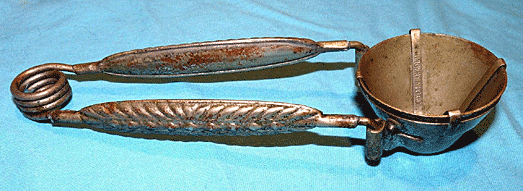
Edson C. Baughman developed the first scoop, made by the
Kingery Company, for one-hand operation in 1894. All a "soda
jerk" had to do was squeeze the split handle to release it.
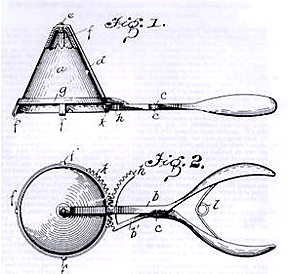 While
working as a drugstore porter in Pittsburgh, African
American Alfred L. Cralle noticed that the popular treat of
ice cream was sticking to spoons, making it difficult to
serve to customers. He decided to design an implement that
would keep the ice cream from sticking and be easy to use
with one hand. He solved the sticking problem in 1897 with a
new type of scoop that had a revolving ring. Originally
called an Ice Cream Mold and Disher, it kept ice cream and
other foods from sticking. But he didn’t become famous for
his invention because it spread widely so quickly that
people soon forgot or never knew Cralle as the inventor. While
working as a drugstore porter in Pittsburgh, African
American Alfred L. Cralle noticed that the popular treat of
ice cream was sticking to spoons, making it difficult to
serve to customers. He decided to design an implement that
would keep the ice cream from sticking and be easy to use
with one hand. He solved the sticking problem in 1897 with a
new type of scoop that had a revolving ring. Originally
called an Ice Cream Mold and Disher, it kept ice cream and
other foods from sticking. But he didn’t become famous for
his invention because it spread widely so quickly that
people soon forgot or never knew Cralle as the inventor.
Cralle’s scoop enabled the creation of the ice cream cone
during the 1904 St. Louis World’s Fair. From then on, people
used his ice cream scoop both commercially and in their
homes.
Ice cream scoops are interesting and practical to collect.
Reading about their development and the people responsible
for it is fascinating and serves as a good history lesson.
<
Back to Readers Ask Archives
Next Article > |
